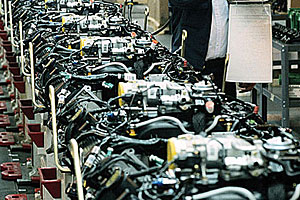
|
After a harrowing winter climate that put additional hurdles in front of the slowly recovering U.S. economy, early signs of spring recovery are brightened by a better-than-expected bounce back of the manufacturing sector.
The most important statistic, capacity utilization of existing U.S. production capability, has actually surpassed that which existed early in 2008. This was prior to a veritable collapse, which hit rock bottom with a 16% retraction from that year’s beginning. It did so in early March 2009 simultaneously with the stock market’s low point — a time period generally recognized as the depth of the recession.
The Federal Reserve’s “Beige Book,” which describes economic conditions throughout the central bank’s 12 districts, summarizes the overall outlook as “modest to moderate.” In commenting on specific regions, it cited the Midwest, especially the greater Chicago area, as being in the early stages of a rebound in both manufacturing and some aspects of construction. However, the Cleveland and St. Louis areas seemed not to have gained their comeback footing as yet.
However, the Beige Book reinforces recent reports that show both hiring and consumer spending generally on an upward swing. This especially seems to apply to automotive sales that have recently accelerated after a 60- to 90-day interlude caused by the worst winter in recent memory. In the industrial arena there are growing signs of significant expansion with increased truck traffic, port volumes and steel production picking up the pace.
While the labor market seems to be improving in small steps almost everywhere, the ability to find skilled workers is reaching a critical crossroads. With no aggressive government-backed programs in sight, businesses in Chicago have indicated developing training programs in-house and through partnerships with local schools.
Housing is the one sector that shows little indication of breaking out of the frosty winter inaction. Chicago real-estate brokers report home sales declined due to cold weather, but cite optimism over preliminary activity pointing to a comeback in late spring and the months beyond.
However, the Southeast, Southwest and Northwest areas, which had been in the forefront of housing recovery since the end of the financial recession, indicate the housing construction expansion of last year seems to have stalled. Both new construction and existing home sales slowed as price increases for the residential housing sector, both in purchases and leasing, may have gotten ahead of where potential buyers are motivated, even with the continuing low cost of money, but with the rate of mortgages accelerating.
Exports, all aspects of energy development and the agricultural rebound suffering from the recent double whammy of the icy winter in the East and Midwest, and the drought in California, are contributing to a much-improved overall economic expectation by mid-year. The second half of 2014 could see a major leap forward, surpassing the expected 2.6% to 3% annualized GDP by the fourth quarter.
Also contributing to this belief is the unusual volume of industrial/commercial projects now in the early stages and the impressive business borrowing that the nation’s banks are experiencing.
Banner year for small businesses?
According to a featured item in a highly respected business newsletter, small businesses are on the way to a record year in all aspects of growth. In referring to small business, this publication limits its description to companies with employees of 100 or less.
This projection indicates this highly regarded cornerstone of America’s unique independent business infrastructure will enjoy its best pace of growth since 2007. It further predicts double-digit gains are in sight for many of these independents, who make up 98% of all the nation’s free-standing firms, one-quarter of U.S. sales and one-third of America’s workers. Further information predicts those businesses tied to energy and construction, home maintenance and health care will predominate among these dynamic small-business entities. Also included are restaurants, entertainment entities, plus retail and distribution establishments whose growth will be spurred by America’s expansion of consumer demand.
These small-business establishments will benefit from this year’s lull in the ongoing political Washington infighting, plus the easier credit that will be made available by banks and other financial institutions that view such well-managed small businesses as good credit risks because of their focused connections with customers and suppliers alike.
Although banks generally are forced to be more inflexible due to Dodd-Frank financial regulations, they realize the transparency of companies with less than 100 employees is easier to work with minus the layered management levels they normally encounter in larger independents and publicly-held corporations.
The biggest problem facing small businesses is the constant drumbeat by the federal government of minimum wages, employee health benefits and other mandatory perks that these entities justifiably find disproportionately oppressive.
Despite these additional headaches, the entrepreneurial nature of small businesses and their ability to be flexible in seizing opportunities offered by the fast-changing nature of the marketplace makes it more likely that they will be the economy’s prime beneficiaries. This is especially true if the more optimistic objectives for the U.S. economy are achieved.
Natural gas takes center stage
It wasn’t too long ago that natural gas was flared off rather than stored, as fracking became the cost-effective generator of U.S. oil production. In fact, less than a decade ago U.S.-based terminals were contemplated to receive liquid natural gas from Qatar and Algeria. Natural gas primarily was needed as electric utility coal replacement and for winter heating needs.
The simultaneous and sudden confrontation between the U.S./European Union and Russia, plus the accelerating commercial industrial use of natural gas and its LNG potential, has vaulted this once nebulous fossil fuel into the front ranks of worldwide importance.
As Russia uses its natural gas pipeline dominance over Europe as a geopolitical advantage, the pending termination of nuclear power by Germany, France and Japan has put natural gas into the primary energy spotlight.
The recent U.S. winter freeze has taxed once easily available natural gas storage supplies, while major chemical companies are expanding U.S.-based facilities to the more cost-effective utilization of home-grown natural gas for commercial end-use derivatives.
What is most remarkable about this consummate impact of the sudden popularity of natural gas is that the price in the U.S. still is hovering below $5 per 1 million Btu (the universal cost indicator). This is multiplied to two or three times that amount in all overseas markets.
With such unparalleled simultaneous circumstances coming together, it seems only a matter of time before the international supply/demand factor will force both prices and demand shortages into crisis mode — not only in the U.S., but worldwide.
But even an urgent speed-up of the many terminals needed to fulfill forthcoming needs would take multiple years, and wide-open amounts of shale fracking before U.S. liquid natural gas could become a recognizable competitor.




